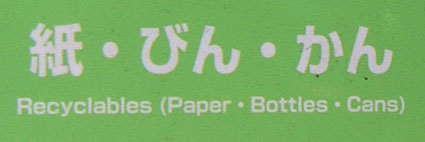KanKan is one of those unique occasions where a Sino-Japanese word just happened to be fairly close in meaning and pronunciation to an English word. As a result, there was a ready-made Chinese character just waiting for the word 'can' when it was imported from English, unlike other words that had to make do with katakana. The character is 缶, and it is a member of the Joyo Kanji, meaning that it is found in normal Japanese text such as the following:
Sometimes kan is written in katakana as カン, but unlike tabako, this doesn't necessarily imply that it has been labelled a word of foreign origin. In the example below, for a recycling bin, kan is written in katakana simply because both bin and botoru are (ビン and ボトル).
Sometimes the same word can be found written かん in hiragana, as in the following rubbish and recycling sign:
The following are Google results in August 2003 for kan-kōhii 'canned coffee'
It is somewhat surprising that, given the tendency in many cases to assimilate words to katakana -- i.e., if one element is normally written in katakana the whole word may be written in katakana -- to find that カンコーヒー is so infrequently used. For comparison, here are similar Google results for kan-zume 'canned'. 缶 is the overwhelming favourite:
|
| Previous Next |


